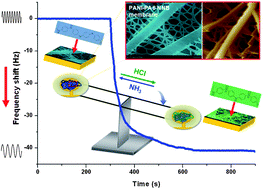Nanofiber-net-binary structured membranes for highly sensitive detection of trace HCl gas
Abstract
This work describes the detection of trace hydrogen chloride (HCl) gas through analyses of the resonance frequency signal from quartz crystal microbalance (QCM) sensors coated with polyaniline (PANI) functionalized polyamide 6 (PA 6) (PANI-PA 6) nanofiber-net-binary (NNB) structured membranes. The PA 6 NNB substrate comprising nanofibers and spider-web-like nano-nets fabricated by a versatile electro-spinning/netting (ESN) process offered an ideal interface for the uniform PANI functionalization and enhanced sensing performance. Benefiting from the large specific surface area, high porosity, and strong adhesive force to the QCM electrode of the PANI-PA 6 NNB membranes, the developed HCl-selective sensors exhibited a rapid response, good reproducibility and stability, and low detection limit (7 ppb) at room temperature. Additionally, the PANI-PA 6 NNB sensing membranes presented visible color changes upon cycled exposure to HCl and ammonia, suggesting their potential application in the development of colorimetric sensors. The PANI-PA 6 NNB coated QCM sensors are considered to be a promising candidate for trace HCl gas detection in practical applications.


 Please wait while we load your content...
Please wait while we load your content...